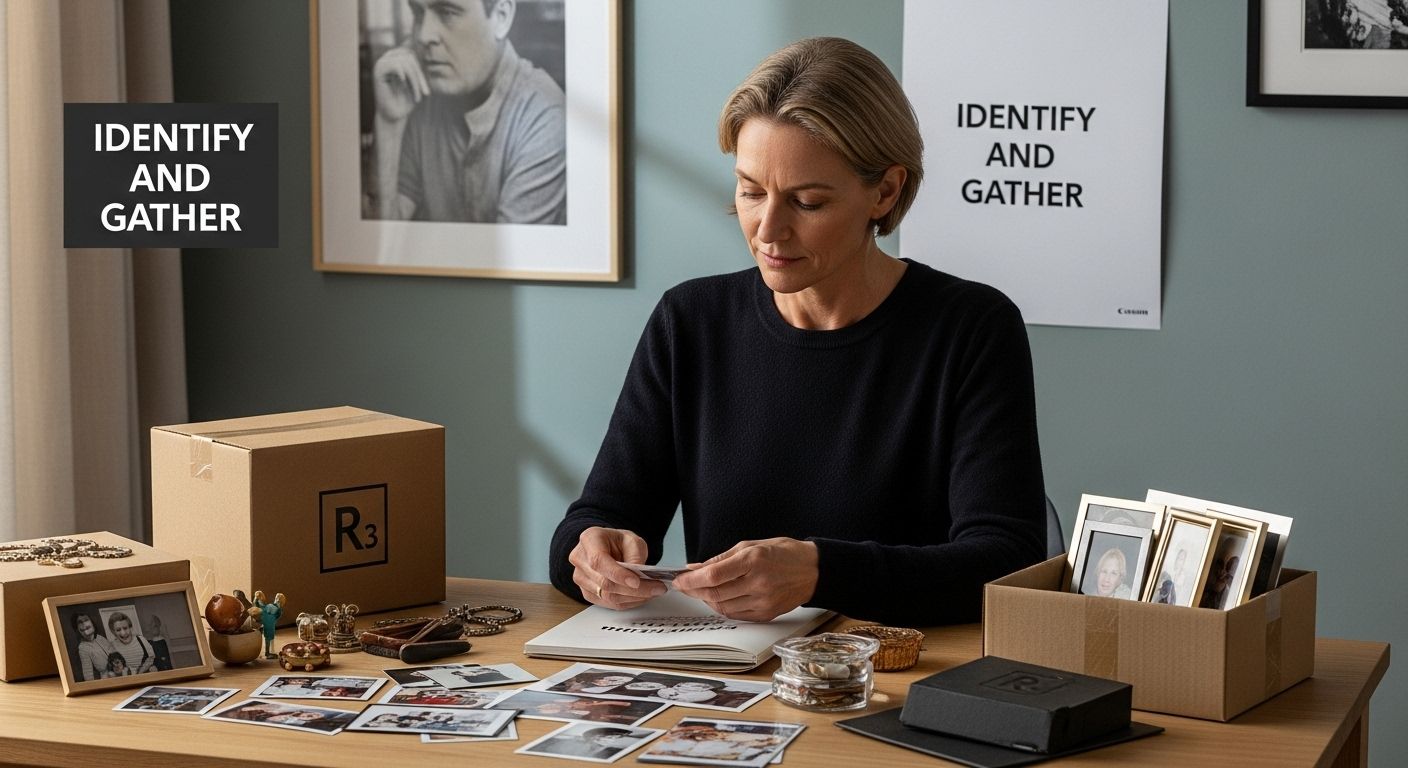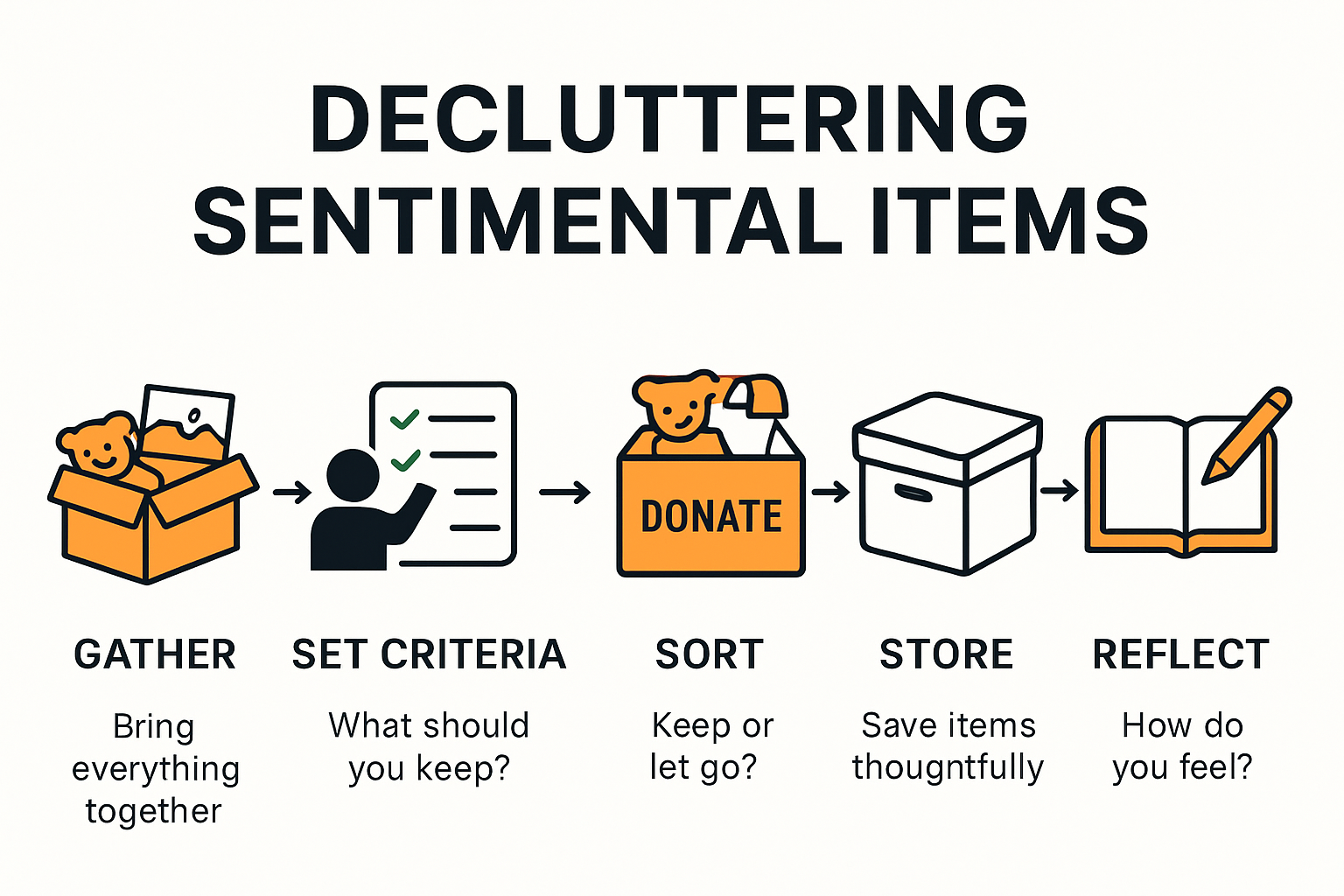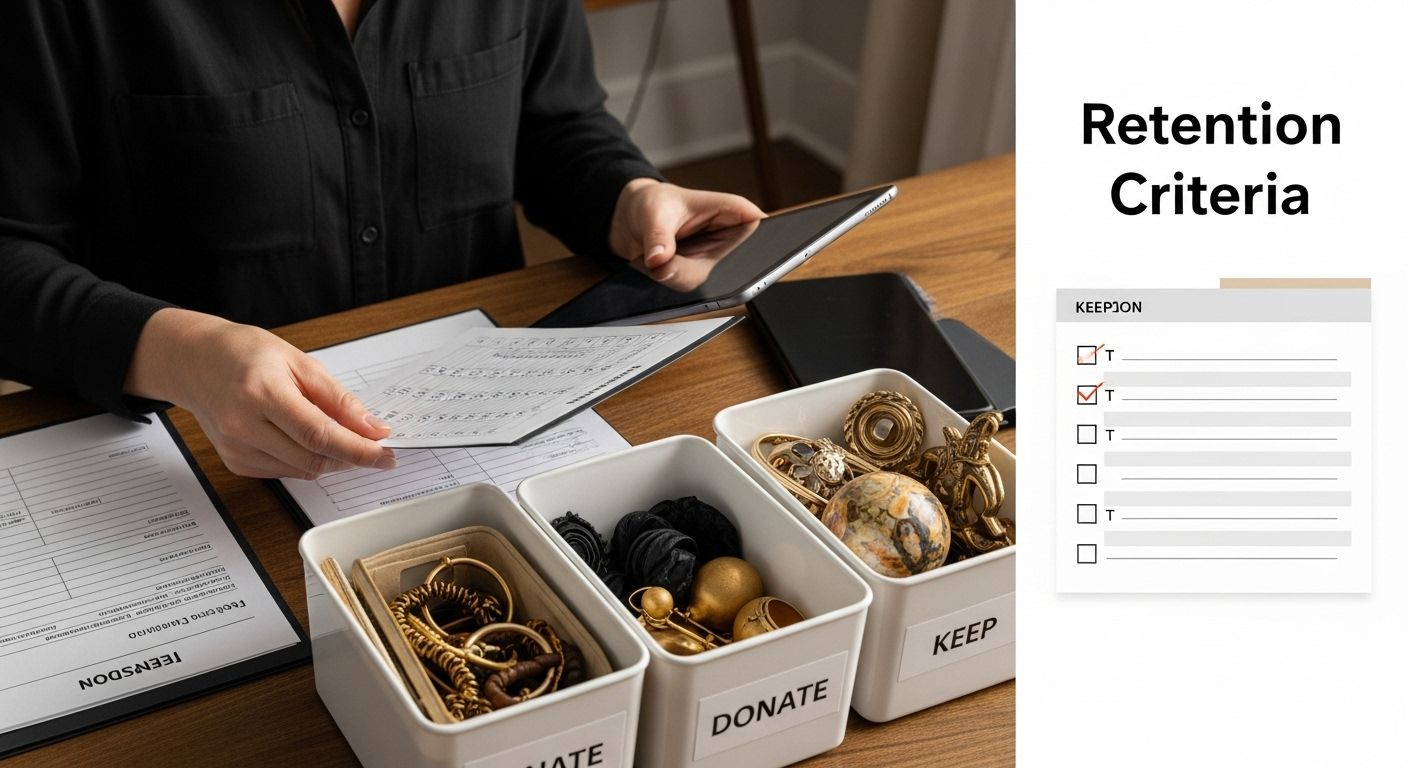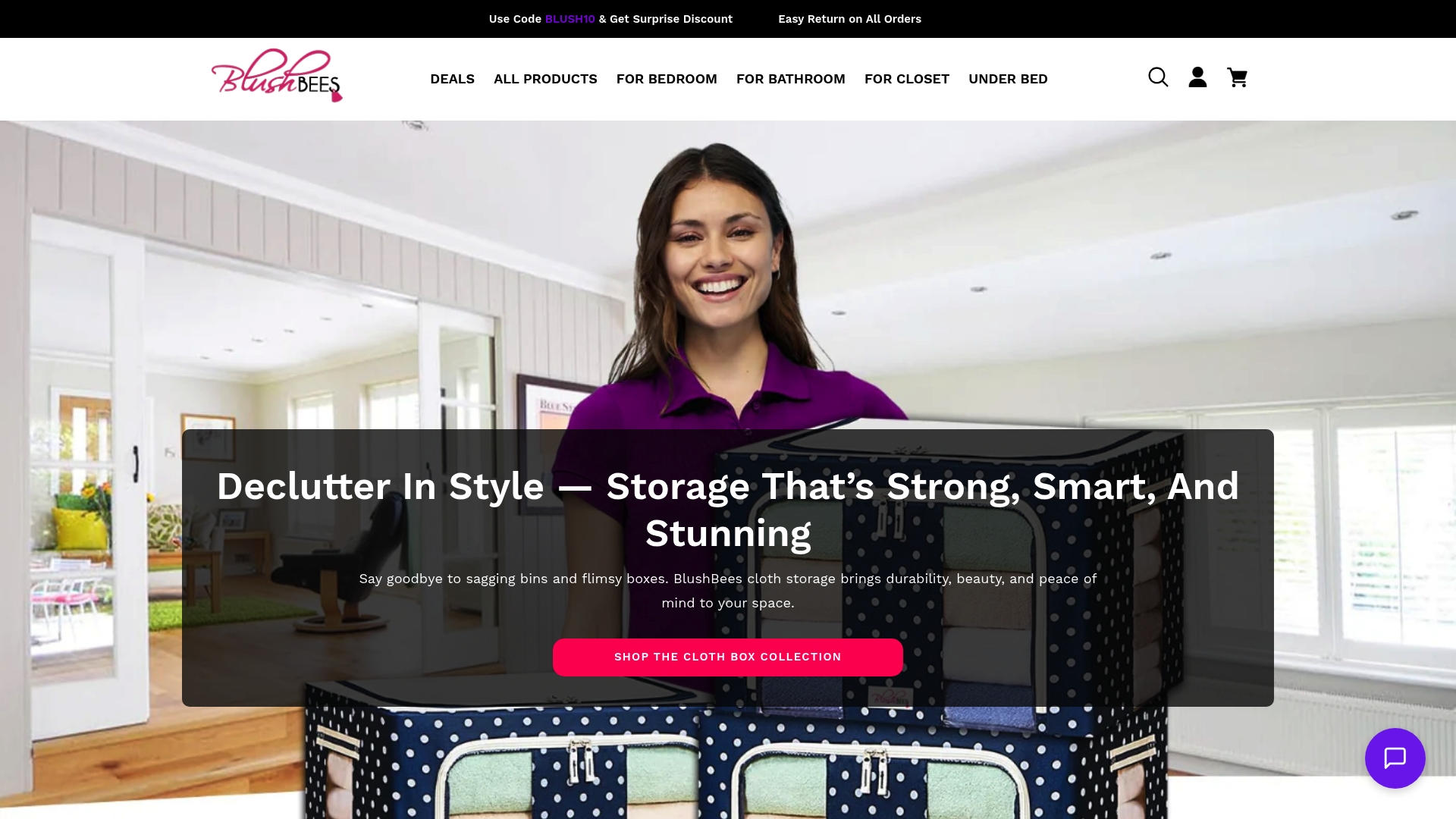
Sorting through sentimental items can feel like walking into a room filled with decades of memories all piled up at once. Most people assume it takes weeks or even months to make any real progress. Yet research shows that photographing your sentimental belongings actually helps you let go of more items without regret, making the whole process less overwhelming and far more satisfying than you might expect.

Table of Contents
- Step 1: Identify And Gather Sentimental Items
- Step 2: Set Criteria For Retention Or Discarding
- Step 3: Sort Items Into Keep, Donate, And Discard
- Step 4: Create Stylish Storage Solutions
- Step 5: Reflect And Verify Your Choices
Quick Summary
| Key Point | Explanation |
|---|---|
| 1. Gather sentimental items in one space | Create a dedicated area to organize items, allowing for focused reflection on their emotional significance. |
| 2. Establish clear retention criteria | Develop guidelines for keeping or discarding items based on emotional value and practical use. |
| 3. Sort items into three categories | Create labeled sections for items to keep, donate, or discard, ensuring each choice is intentional. |
| 4. Use stylish storage solutions | Choose attractive storage options that reflect your decor while keeping sentimental items protected. |
| 5. Reflect on your choices thoroughly | Take time to review your selections, ensuring they align with your current life narrative and emotional needs. |

Step 1: Identify and Gather Sentimental Items
Decluttering sentimental items requires a strategic and compassionate approach that honors your memories while creating space for new experiences. The first step involves systematically gathering and categorizing items that hold emotional significance, transforming an overwhelming task into a manageable process of reflection and intentional decision making.
Begin by creating a dedicated workspace where you can spread out your sentimental belongings without interruption. This might be a clear table, bedroom floor, or large counter surface that allows you to view everything comfortably. Select a time when you feel emotionally stable and have several uninterrupted hours to focus. Consider preparing some supportive elements like a cup of tea, soft background music, and tissues to help you navigate potential emotional moments.
As you collect items, group them into broad initial categories that help you understand the emotional landscape of your possessions. These categories might include family heirlooms, photographs, childhood mementos, gifts from loved ones, and personal achievement memorabilia. By visually organizing these items, you create a map of your emotional attachments that will guide your subsequent decluttering decisions.
Understand that this process is not about ruthlessly discarding memories but about curating a collection of items that truly represent your most meaningful experiences. Learn more about mindful organization strategies that can help you approach this task with intention and care.
According to research from Penn State University, photographing sentimental items can help ease the emotional difficulty of letting go. Consider taking high quality digital photographs of items you might not keep, preserving their memory without maintaining physical storage.
By the end of this step, you should have:
- A comprehensive collection of all sentimental items in one location
- Broad categorical groupings of these items
- A sense of emotional readiness to make thoughtful decisions in the next decluttering stage
Remember, identifying and gathering your sentimental items is an act of self compassion. Approach the process gently, allowing yourself space to feel and reflect as you prepare for the next phase of your decluttering journey.
Step 2: Set Criteria for Retention or Discarding
Establishing clear criteria for managing sentimental items transforms an emotionally charged process into a structured, intentional decision making exercise. This critical step helps you create objective guidelines that balance emotional attachment with practical considerations, ensuring you preserve meaningful memories without drowning in unnecessary physical clutter.
Develop your personal retention framework by asking yourself strategic questions about each item. Consider the item’s true emotional significance, practical utility, and the genuine joy it brings to your life. Does this object represent a pivotal moment or relationship? Will keeping it meaningfully contribute to your current life narrative, or is it merely occupying space out of guilt or obligation?
Implement a structured evaluation approach that goes beyond simple nostalgia. Explore comprehensive organization strategies that can help refine your decision making process. According to research from the Mississippi State University Extension Service, creating specific allocation spaces and selecting representative items from collections can significantly streamline your decluttering efforts.
Establish a balanced set of retention criteria that might include:
- Items directly connected to significant life experiences
- Objects that spark genuine positive emotional responses
- Artifacts representing unique family history or personal achievements
- Pieces with demonstrable ongoing practical or decorative value
Consider adopting a numerical or weighted scoring system to make your decisions more systematic. Assign points based on emotional significance, current relevance, and potential future value. This approach transforms subjective emotional decisions into a more objective evaluation process, helping you make clearer choices about which items truly deserve space in your life.
Photographing items you decide to release can provide an additional emotional buffer. This strategy allows you to preserve the memory without maintaining physical possession, creating a digital archive that captures the essence of your sentimental belongings without contributing to physical clutter.
By the conclusion of this step, you should have a clear, personalized framework for distinguishing between items worth keeping and those ready to be thoughtfully released. Your criteria will serve as a compassionate yet practical guide, helping you curate a collection of sentimental items that genuinely reflect your most cherished memories and current life journey.

Step 3: Sort Items into Keep, Donate, and Discard
Sorting sentimental items requires emotional intelligence and practical decision making. This pivotal step transforms your collected memories into intentional, purposeful collections that honor your past while creating space for future experiences. The goal is to create three distinct categories: items to keep, items to donate, and items to discard, each representing a thoughtful choice about your personal belongings.
Prepare three clearly labeled containers or designated spaces for each category. Your sorting area should be well lit, spacious, and free from distractions that might trigger impulsive decisions. Consider using color coded boxes or containers that help you visually distinguish between keep, donate, and discard piles. Discover smart organizational techniques that can streamline your sorting process and maintain emotional clarity.
According to research from the Mississippi State University Extension Service, selecting representative items from collections rather than keeping entire sets can significantly reduce clutter while preserving meaningful memories. When sorting, ask yourself critical questions about each item: Does this object genuinely contribute to my current life? Would someone else find more joy or use in this item?
Your sorting criteria should include:
- Items that spark immediate, positive emotional connections
- Objects with clear functional or decorative value in your current living space
- Artifacts representing unique personal or family history
- Pieces that align with your future personal and lifestyle goals
For items you decide to release, consider photographing them as a way to preserve the memory without maintaining physical possession. This approach allows you to emotionally detach while creating a digital archive of meaningful moments. Be compassionate with yourself during this process, recognizing that letting go does not diminish the significance of your memories.
The donate category should include items in good condition that could bring value to others. Research local charities, community centers, or schools that might appreciate these meaningful contributions. For items marked for disposal, ensure proper environmental disposal methods, especially for fragile or potentially hazardous objects.
By the end of this step, you should have three clearly defined collections: a curated set of kept items that truly matter, a group of items ready to be donated and appreciated by others, and a small collection of items responsibly prepared for disposal. Your sorting process transforms cluttered memories into a purposeful, organized reflection of your life’s most cherished experiences.
Step 4: Create Stylish Storage Solutions
Transforming your sentimental items into beautifully organized collections requires thoughtful storage solutions that blend functionality with aesthetic appeal. This critical step goes beyond simple containment, focusing on creating display and preservation methods that honor your memories while maintaining a clean, stylish living environment.
Begin by selecting storage containers that complement your home’s existing decor. Look for pieces that not only protect your sentimental items but also serve as elegant display elements. Explore innovative small space storage strategies that can help you maximize both style and functionality in your storage approach.
According to research from the Mississippi State University Extension Service, creating designated spaces for sentimental items and selecting representative pieces from collections can significantly improve your organizational process. Consider investing in high quality storage solutions that offer both protection and visual appeal, such as:
- Archival quality boxes with acid free tissue paper
- Clear glass display cases for most treasured items
- Decorative wooden chests with protective interior linings
- Modular storage systems that can be easily reconfigured
Develop a strategic approach to displaying and storing your most meaningful items. Some pieces might benefit from rotation display methods, where you periodically showcase different memories while keeping others safely stored. This approach allows you to enjoy your sentimental collection without overwhelming your living space.
Consider the specific preservation needs of different types of sentimental items. Photographs require acid free storage materials, while fabric items might need climate controlled environments. Metals should be protected from humidity, and delicate paper documents need archival quality protection. Each type of memento demands specialized care to ensure its long term preservation.
Implement a labeling system that helps you quickly identify and access your stored items. Use clear, elegant tags or digital inventory methods that make retrieving memories simple and stress free. This organizational approach transforms your sentimental collection from a potential source of clutter into a curated, meaningful archive that tells your unique personal story.
By the end of this step, you should have a cohesive storage system that protects your cherished items, complements your home’s aesthetic, and allows you to easily interact with your most meaningful memories. Your storage solutions become more than just containers they become a thoughtful presentation of your life’s most significant moments.
Below is a table that summarizes the key storage solutions mentioned in the article, including each option’s advantages and typical use, to help you select the most effective method for preserving your sentimental items.
| Storage Solution | Protective Features | Best For |
|---|---|---|
| Archival quality boxes | Acid-free, protects from deterioration | Photographs, paper documents |
| Clear glass display cases | Visibility, dust protection | Treasured collectibles, fragile items |
| Decorative wooden chests | Durable, lined interior | Keepsakes, fabric items |
| Modular storage systems | Reconfigurable, maximizes space | Mixed memorabilia, evolving collections |
| Rotational display systems | Allows item rotation, easy access | Varied mementos, seasonal displays |
| Labeled bins or containers | Easy identification, organized access | Everyday sentimental items |
Step 5: Reflect and Verify Your Choices
Reflection is the cornerstone of meaningful decluttering, transforming a mechanical sorting process into a profound personal journey of understanding and growth. This final step ensures that your decisions about sentimental items are intentional, emotionally balanced, and aligned with your current life narrative.
Schedule dedicated time for a comprehensive review of your sorting and storage process. Create a quiet, contemplative environment where you can honestly evaluate your choices without external pressures or distractions. Explore additional organization strategies that can support your reflective process and help maintain your newfound clarity.
According to research from ColumbiaDoctors, decluttering can significantly reduce stress and anxiety, contributing to improved mental well-being. As you review your selections, focus on the emotional weight each item carries and its genuine significance in your present life.
Establish a verification process that includes:
- Confirming each kept item truly sparks joy or serves a meaningful purpose
- Verifying that donated items are in good condition and will benefit others
- Ensuring discarded items are responsibly disposed of
- Checking that your storage solutions effectively protect and display important memories
Emotional verification is just as crucial as physical sorting. Allow yourself to sit with your choices, experiencing any emerging feelings without judgment. Some items might trigger unexpected emotions realize this is a natural part of the process. If you find yourself hesitating about a particular item, it might be worth revisiting and reassessing.
Consider creating a digital or physical journal documenting your decluttering journey. Photograph the items you’ve chosen to keep, write brief narratives about their significance, and record your thoughts and feelings during this process. This documentation serves as both a memory preservation technique and a personal reflection tool.
During your verification, be compassionate with yourself. Understand that decluttering sentimental items is not about ruthlessly eliminating memories, but about curating a collection of meaningful experiences that genuinely represent your life’s story. Your goal is to create a living space that feels authentic, peaceful, and truly reflective of who you are right now.
By the end of this step, you should feel a sense of emotional clarity and physical lightness. Your sentimental items are now purposefully organized, stored with intention, and aligned with your current life journey. You have transformed potential clutter into a meaningful, curated collection of memories that brings you joy and peace.
Use the following checklist table during your final reflection stage to ensure you have thoroughly reviewed your decisions and created an organized, meaningful collection.
| Verification Task | Description | Completed (Yes/No) |
|---|---|---|
| Confirm sentimental value of kept items | Ensure each item truly sparks joy or holds strong meaning | |
| Review condition of donated items | Make sure all donations are in good condition | |
| Responsible disposal of discarded items | Confirm all disposals are done properly and safely | |
| Inspect effectiveness of storage solutions | Storage adequately protects and displays items | |
| Document memories | Photograph or journal the significance of special items | |
| Reflect on emotional readiness | Assess your feelings about the final selections |
Transform Sentimental Clutter Into a Beautifully Organized Sanctuary
Sorting through sentimental items can be overwhelming. You want to honor your memories, but clutter makes your bedroom feel more stressful than peaceful. The article walked you through reflecting, sorting, and creating practical solutions. Now it is time to give your treasured keepsakes the thoughtful home they deserve. Imagine revisiting meaningful moments in a calm, organized space day after day. The right storage system makes this possible.

Discover the perfect blend of style and efficiency with Bedroom Storage – BLUSHBEES USA. Explore boxes, bins, and display solutions that protect your cherished items while enhancing your décor. You can even maximize space with specialized options from our Underbed Storage – BLUSHBEES USA collection. Do not let meaningful possessions become messy piles. Visit https://blushbees.us now to find exclusive offers created just for organized, sentimental living. Choose peace and order today—start curating your memories with confidence.
Frequently Asked Questions
How do I start decluttering sentimental items?
Begin by gathering all your sentimental belongings in one space and categorizing them into broad groups. This will help you visualize your items and prepare for the decluttering process.
What criteria should I use to decide what sentimental items to keep?
Consider the emotional significance, practical utility, and joy each item brings to your life. Ask yourself if the item represents a significant moment, serves a purpose, or aligns with your current life narrative.
How can I store sentimental items beautifully?
Choose storage solutions that complement your home decor, like decorative boxes or display cases. Ensure these solutions provide protection while also allowing you to display your cherished memories stylishly.
What should I do with items I decide to discard or donate?
Photograph items you’re letting go of to preserve their memory. Donate items in good condition to local charities, and ensure that discarded items are disposed of responsibly and environmentally friendly.
Recommended
- How to Declutter Before Moving: Tips for a Fresh Start in 2025 – BLUSHBEES USA
- What Is Decluttering? Simple Tips for Organized Living – BLUSHBEES USA
- How to Reduce Clutter: Simple Steps for a Tidy Home – BLUSHBEES USA
- Having Fun While Staying Tidy. Is It Possible? – BLUSHBEES USA
- Efficient vs. Traditional Packing: Key Pros and Cons



